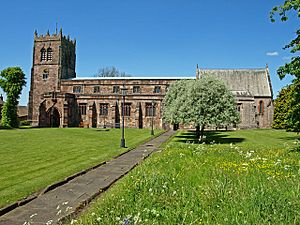Kirkby Stephen Parish Church facts for kids
Quick facts for kids The Parish Church, Kirkby Stephen |
|
|---|---|

The Parish Church, Kirkby Stephen
|
|
| 54°28′26.28″N 2°20′54.79″W / 54.4739667°N 2.3485528°W | |
| OS grid reference | NY 77517 08821 |
| Location | Kirkby Stephen |
| Country | England |
| Denomination | Church of England |
| Churchmanship | Broad Church / Central |
| History | |
| Dedication | None St Stephen or St John possible former dedications. |
| Architecture | |
| Heritage designation | Grade II* listed |
| Specifications | |
| Bells | 8 in F |
| Tenor bell weight | 15 Cwt |
| Administration | |
| Parish | Kirkby Stephen with Mallerstang and Crosby Garrett with Soulby |
| Deanery | Appleby |
| Archdeaconry | Carlisle |
| Diocese | Diocese of Carlisle |
| Province | Province of York |
Kirkby Stephen Parish Church is a special old church in Kirkby Stephen, Cumbria, England. It belongs to the Church of England. People sometimes call it "St Stephen's Church" because of the town's name, but it doesn't officially have that dedication. This church is so important that it's listed as a Grade II* listed building, which means it's a very significant historic place.
Contents
History of the Church
You can find the church near Kirkby Stephen market square. It's a bit hidden by the cloisters, which are covered walkways built in 1810. The church is sometimes called the "Cathedral of the Dales" because it's so large. In Cumbria, only Kendal Parish Church is bigger.
There have been three churches built on this same spot over many years.
- The first church was built a very long time ago, during the Anglo-Saxon period.
- From this time, a piece of a stone cross still exists. It shows a carving of Loki, a god from Norse mythology, who is shown tied up with chains. This is called the "Loki Stone".
- Around 1170, the Anglo-Saxon church was replaced by a Norman church. You can still see parts of the walls from this Norman church in the west wall of the north aisle.
The church was mostly rebuilt again around 1230. However, it has been changed a lot since then.
- Some parts from the 13th century that are still there include the nave arcades (rows of arches), the north transept (a part of the church that sticks out), and the piscina (a basin for washing sacred vessels) and sedilia (seats for clergy) in the chancel (the area around the altar).
- In the 15th century, the windows and door on the south side were replaced.
- The tall tower was built in the 16th century.
- Later, in 1847, the chancel, the chapels next to it, and the south transept were rebuilt.
- In 1871, the north wall of the north aisle and the south porch were rebuilt.
- Many other parts, like the clerestory (upper windows) and south aisle windows, were also updated in the 19th century. A lot of the stone inside was also repaired or changed.
The church does not have an official dedication to a saint. There is no real proof that it was dedicated to St Stephen or St John, even though people sometimes refer to it as 'St Stephen's Church'. This name comes from the town's name, Kirkby Stephen.
What is a Parish?
A parish is like a local area that a church serves. Kirkby Stephen Parish Church is part of a larger parish. This parish includes St Andrew's Church in Crosby Garrett and St Mary's Church in Mallerstang.
Since 1990, the church has also been shared with the Roman Catholic community. This means both groups use the church for their services.
Special Memorials
The church has some interesting old tombs and memorials.
- The north chapel, also known as the Wharton chapel, has a tomb from the late 16th century. On top of it are statues, called effigies, of Thomas Wharton, 1st Baron Wharton (who lived from 1495 to 1568) and his two wives.
- The south chapel, called the Hartley chapel, has two more old tombs. One is from the early 15th century with an effigy of Sir Richard Musgrave (who died in 1409). The other is also from the 15th century and belongs to another Sir Richard Musgrave (who died in 1464). This chapel is dedicated to St Paul.
Music and Bells
The church has a large pipe organ that was installed in 1888. A pipe organ is a musical instrument that makes sound by sending air through pipes. You can find more details about this organ on the National Pipe Organ Register.
The church also has a set of 8 bells. These bells can be rung together to make music. The largest bell, called the tenor, weighs about 15 hundredweight (which is about 762 kilograms) and is tuned to the note F. Most of the bells were made by John Warner & Sons of London in 1877. The 7th bell was made earlier, in 1849, by Edward Seller.
Pictures of the Church
-
The "Loki Stone", a piece of an Anglo-Saxon cross with a carving of Loki.
More to Explore
- Grade II* listed buildings in Westmorland and Furness
- Listed buildings in Kirkby Stephen



